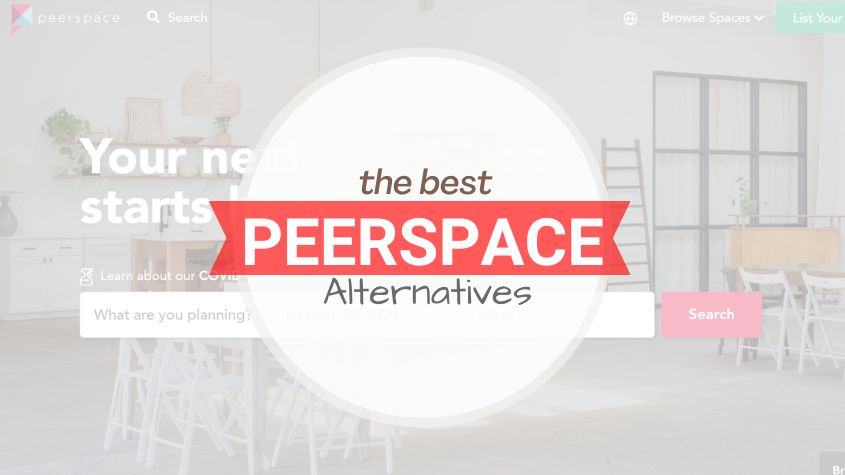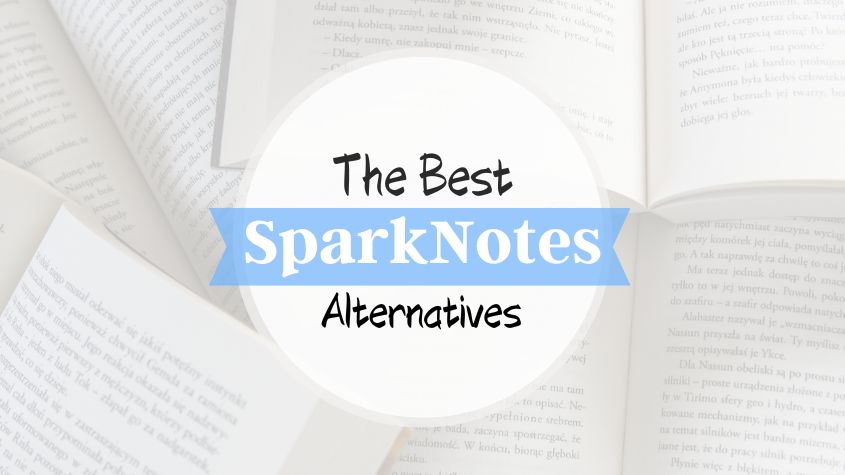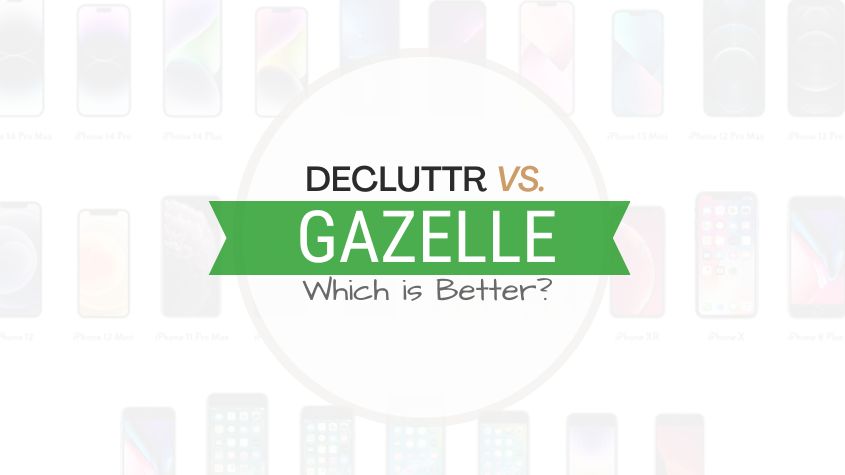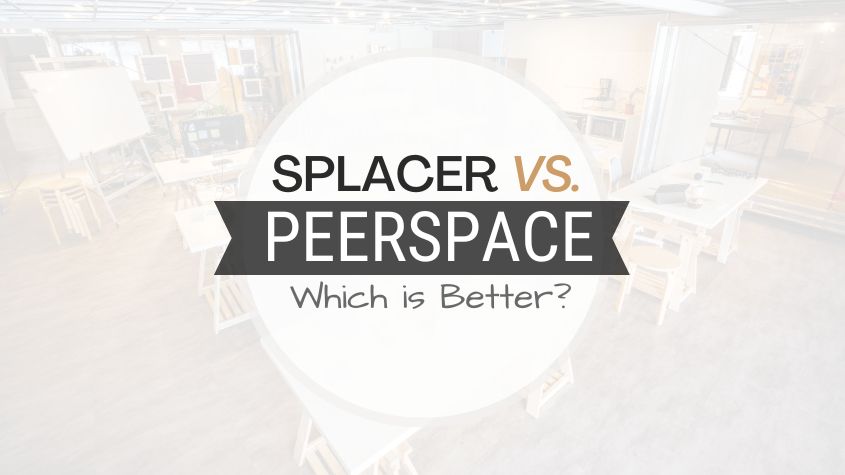In this Toptal vs. Crossover comparison, we will look at how the two recruitment platforms stack up against each other on the most important fronts in the hope it will help you make a guided decision.
What Is Toptal?
Toptal describes itself as a platform that helps connect the world’s top talent with the world’s top organizations.
To back its claim, the company has received well over 2 million talent applications thus far and facilitated 55,000+ talent engagements.
The name Toptal is derived from the words “top” and “talent”. There is a reason for this, apparently. Only about 3 percent of all Toptal applications are accepted.
The company has a rigorous screening process that only allows real experts to make the cut.
What Is Crossover?
Crossover does exactly what Toptal does, which is to match top talents with employers.
The main difference is that Crossover focuses strictly on remote opportunities. Also, it targets the top 1% of talents, making it even stricter than Toptal.
How Toptal Works
Contrary to popular notion, Toptal doesn’t hire. It only helps companies hire.
In other words, it does the dirty work of separating the poor from the good, and only provides top-quality candidates to hiring teams.
As a jobseeker, you can bank on Toptal to bring to you the very best opportunities and communicate your talent and competence to the employers.
Most of its clients are renowned corporations with high performance expectations, so you can be sure the salaries are top-tier as well.
Who Can Join Toptal?
Anyone can join Toptal. It doesn’t matter your location or whether or not you’re currently employed.
That said, when signing up you will need to state your area of expertise. It has to be one of the following per the registration page:
- A software developer
- A designer
- A finance expert or management consultant
- A project manager
How To Sign Up On Toptal
At the top right corner of the Toptal homepage, there is a link to “Apply as a Freelancer”. Click it.
A registration form will open asking you to state your field of expertise, provide your full name and email, and create an account password.
You can also sign up with LinkedIn, which is less cumbersome, even if just marginally.
In the next page, you will be required to customize your profile by stating your location, citizenship, English proficiency on a scale of “basic” to “native/fluent”, and the reason you’re applying to join Toptal.
You will then describe your professional experience and the type of job commitment you prefer.
The last bit is about your freelancing preferences, including your salary expectations, favorite project types, passions, and views about freelancer-client interactions.
The company promises to review your application and get back to you within a day. Just so you know, your chances of receiving an affirmative response are a measly 3%.
How To Find Work On Toptal
Toptal doesn’t work like a traditional job board, so basically you won’t be sending applications to prospective employers.
It’s the other way round instead. Employers find you with Toptal’s assistance. The process is simple. An employer informs Toptal about a job opening in their company.
They describe the job, letting the Toptal team know exactly what they are looking for.
The team then browses their database with the help of an algorithm to try and find the candidate best suited for the opening.
If you are that candidate, Toptal connects you with the employer, who may or may not assess you separately.
Toptal gives its clients a trial period, during which they can choose to drop the candidate and seek another one. So, it’s possible to land a job and lose it immediately.
The key takeaway here is that there is not much you can do to influence your chances of being chosen as the preferred candidate for an opening besides creating a very accurate profile and matching it with the perfect resume.
How Crossover Works
Like Toptal, Crossover doesn’t hire. It helps clients find employees. The difference is how it does that.
Unlike Toptal, which keeps a database of candidate profiles and connects clients with the best profile matches, Crossover puts up listings of openings and lets candidates send applications job-board-style.
Well, your information will be saved afterward, but providing profile details is not the first thing you do. The first thing is to explore the job pool and apply for a job.
In a word, you won’t be accorded a fixed definition upon registration. You can apply for as many jobs as you can, and they don’t have to be within a specific field.
Who Can Join Crossover?
Available in 130+ countries, Crossover is a global recruiting company.
Companies the world over use it to fill positions, and there is no limit to the kind of jobs they can post.
The only canon, as stated earlier, is that the opportunities must be remote and full-time.
The top categories on the site include:
- Engineering
- Software Architecture & Design
- Consultation
- Product Management
- Sales
- Finance
- Marketing
- Business & Operations
- Executive Leadership
- Education
How To Sign Up On Crossover
Signing up for Crossover can be more straightforward than it currently is. I couldn’t find a way to sign up until I opened a listing and clicked on the “Apply” button.
I was asked to provide my name, email, account password, link to my LinkedIn profile (optional), and resume (optional).
I got signed in automatically after that, and by then I was well into my maiden job application process.
How To Find Work On Crossover
As stated above, Crossover lets everyone apply for everything. So a single listing could attract a few thousand applications.
The site has a very effective way of narrowing down the applications to the top 1% it promises its clients.
In the first step, applicants are taken through a general cognitive aptitude test.
This is a 15-minute grilling exercise that measures the candidate’s problem-solving skills. You expect a good deal of the candidates to pass with flying colors.
The next step is not only more specific but tougher. It’s the skills assessment test. Here, candidates are required to prove their real-world job skills.
Tests vary depending on the job opening in question, but your performance is saved as a skill badge for when a similar opportunity pops up in the future.
This step filters out the applications even further. The remaining ones are reviewed manually, and the best applicants are invited for an interview.
Toptal Vs. Crossover: The Screening Process
Both Toptal and Crossover have detailed screening procedures, but they are not exactly the same.
Toptal’s process is a one-time thing and it can last for up to five weeks.
As a candidate you will be tested for subject matter expertise, communication skills, and professionalism.
Crossover’s screening process, on the other hand, is one-time only to a certain point.
Beyond that, you will be taken through job-specific tests, which last a few minutes each. Live interviews are the preserve of the top 1%.
Even on paper, it’s not easy to tell which of the two processes is easier.
You could say it is Toptal’s since it happens once, but your opinion would easily be challenged if you considered the sheer length of it.
Toptal Vs. Crossover: Opportunities
Toptal offers freelancing opportunities, both full-time and part-time.
Crossover, on the other hand, offers full-time remote opportunities—not part-time or on-site.
Another big difference is that Toptal focuses on a specific set of job categories, while Crossover is more general.
Toptal Reviews And Complaints
Toptal has loads of positive feedback on the internet.
On Trustpilot and Indeed, it has an average rating of 4.7 stars. Here are some of things users have said about it:
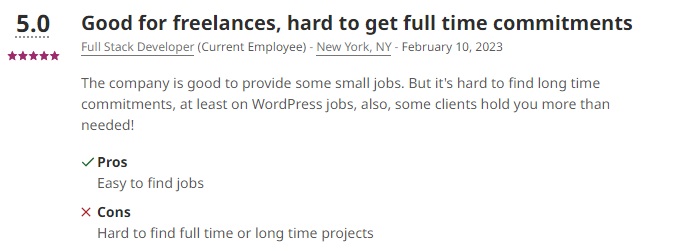

The few complaints I found were mostly about the site’s talent crowdedness and scarcity of opportunities.

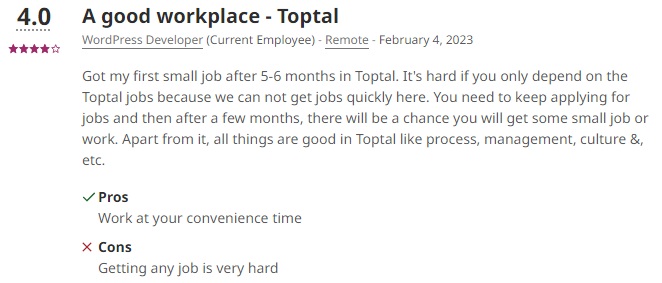
Crossover Reviews And Complaints
Crossover doesn’t seem to enjoy the same positive feedback Toptal does. And from the look of things, this has nothing to do with questionable legitimacy.
The grumbles are generally pointing towards a lack of professionalism, poor communication, privacy invasion, and a complicated hiring process.


There was no shortage of positive feedback either.
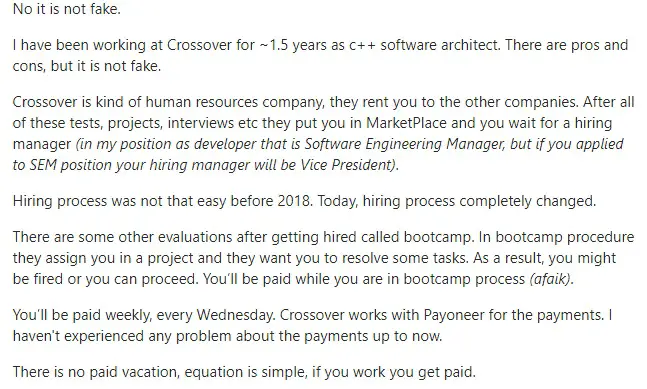

Crossover Vs. Toptal: Verdict
Crossover and Toptal are both well-respected companies, but they won’t serve you the same way. Toptal’s biggest downside is the narrow range of professions it focuses on.
You will only find it useful if you are a software developer, a designer, a project manager, or a finance expert.
Its strongest point is that it connects people with all sorts of jobs: full-time, part-time, remote, and on-site. Crossover only offers remote opportunities.
As regards screening processes, Toptal might have the upper hand. Candidates are taken through their paces only once during registration.
The only other time they are tested is during live interviews, and that’s after they are shortlisted for a job.
Crossover has a set of intricate personality and aptitude tests that keep repeating with every application.
The profile information and resume are quite simply not enough to see you through an application.
Lastly, user reviews seem to favor Toptal. There is no questioning either company’s legitimacy, but there are more satisfied Toptal users than there are Crossover users.
So Toptal wins on our Toptal vs. Crossover comparison!




